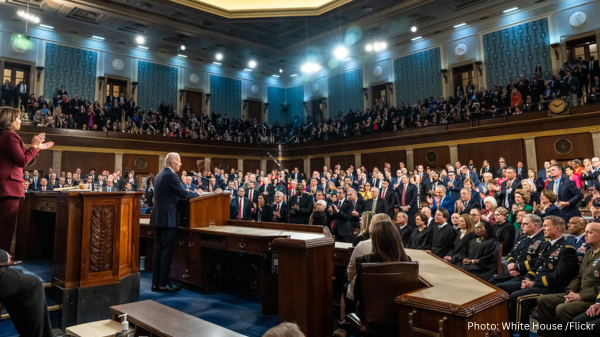New inflation numbers keep economic concerns front and center, as Biden doubles down on high spending and massive borrowing.
by J.D. Tuccille
Rising Prices, Again
“The Consumer Price Index for All Urban Consumers (CPI-U) increased 0.4 percent in February on a seasonally adjusted basis, after rising 0.3 percent in January,” according to the BLS. “Over the last 12 months, the all items index increased 3.2 percent before seasonal adjustment.”
That’s a big improvement over the 9.1 percent that inflation hit in 2022. But it’s still a reminder to the public that the money in their wallets buys less with each passing day. It’s also an open-handed slap—though with the sting felt by consumers—to free-spending politicians who long pantomimed concern about inflation while openly pursuing policies that drove prices to rise.
“For years, economic thinkers on the left pushed for more government spending and urged the Federal Reserve to be less paranoid about inflation, with the goal of driving down unemployment as low as possible,” Victoria Guida wrote last month for Politico.
President Joe Biden and company eagerly adopted the idea, pushing for not billions, but trillions of dollars in spending, deficits, and debt on the theory that Americans would like the results.
But “Americans don’t seem very enthused,” Guida added. “Because they really hate inflation.”
Inflation Causes Pain
People dislike inflation because it’s death to budgeting, savings, and financial planning. Inflation creates a race between wages and prices, making it difficult to know if income will cover the same groceries, rent, and other costs that it did in the past.
“Real average hourly earnings for all employees decreased 0.4 percent from January to February,” BLS announced the same day it released CPI figures. That said, over the past year, there was “a 1.1-percent increase in real average weekly earnings” according to the same news release. But not all measures point to wages keeping up.
“Inflation-adjusted wages have shrunk by 3.7 percent since the end of 2020,” the Manhattan Institute’s Stephen Miran commented in November, based on the Employment Cost Index, a different BLS measure that shows wages still struggling to catch up with the declining value of the dollar. “Worse, the drop in real wages erased all gains made in the late 2010s.”
Either way, it’s enough to say that inflation makes life unpredictable and causes pain.
In the latest monthly survey by the Financial Times and the University of Michigan’s Ross School of Business, inflation ranked as the top economic issue on people’s minds as they determined their votes for president, picked by 67 percent of respondents. Almost two-thirds of respondents said they “cut back on non-essential spending, like vacations, eating out, or entertainment” in response to rising prices; half “cut back on spending for food and everyday necessities.”
Unsurprisingly, people are not happy with politicians who visit inflation upon them. In that survey, 45 percent said President Biden’s economic policies hurt the economy (31 percent said they helped) and 59 percent disapproved of his handling of economic issues (36 percent approved). Americans agree with the White House that the president’s self-labeled “Bidenomics” have had an impact, but they don’t like the results. Many economists concur, specifically when it comes to inflation.
Government Irresponsibility with Money Causes Inflation
“Inflation comes when aggregate demand exceeds aggregate supply,” economist John Cochrane of the Hoover Institution and the Cato Institute wrote this month for the International Monetary Fund. “The source of demand is not hard to find: in response to the pandemic’s dislocations, the US government sent about $5 trillion in checks to people and businesses, $3 trillion of it newly printed money, with no plans for repayment. Other countries enacted similar fiscal expansions and reaped inflation in proportion.”
True, the spending frenzy began when Donald Trump was president, but Biden embraced the idea as his own. Now, the White House boasts of vast “generational investments” that “reverse decades of disinvestment in public goods,” but there’s a direct connection between a tidal wave of government borrowing and spending and the eroding value of people’s money.
“The mantras of the 2010s—’secular stagnation,’ ‘modern monetary theory,’ ‘stimulus’—which preached that prosperity needed only for the government to borrow or print a huge amount of money and hand it out, are in the dustbin. You asked for it. We tried it. We got inflation, not boom,” adds Cochrane.
That leaves the Biden administration wearing the consequences of the “Bidenomics” spending it touted as an albatross around its own neck. There is no escape from policies which politicians deliberately and publicly embraced when the public turns against them.
“There’s a healthy amount of fear and introspection happening among the architects of these efforts that folks aren’t necessarily buying what we’re selling,” a prominent progressive told Politico‘s Guida.
Brace for More of the Same
Unfortunately for anybody who fears irresponsible government largesse leading to ever-more economic chaos, the Biden administration seems determined to double down on high spending and massive borrowing in its economic policies going forward.
“For fiscal year 2025, which begins on October 1 of this year, Biden is asking Congress to spend $7.3 trillion while the federal government will collect just $5.5 trillion in taxes,” Reason‘s Eric Boehm reported this week. “That will necessitate borrowing $1.8 trillion to make ends meet. Over the 10-year window covered by the president’s budget plan, federal revenues would exceed $70 trillion, but Biden is proposing to spend $86.6 trillion.”
With floods of money from the government linked to eroding purchasing power, it’s interesting—for a certain value of the word—to contemplate what BLS news releases about prices and wages might look like in the years to come. And to anticipate the corresponding pain from pinched budgets.
Originally published by the Reason Foundation. Republished with permission.
For more Budget & Tax News.











